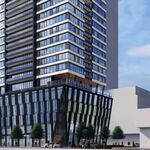AlvinofDiaspar
Moderator
From the Globe, by John Barber:
BUILDING RENEWAL
An urban plan that rises high above failed promises
JOHN BARBER
jbarber@globeandmail.com
August 28, 2008
Mayor David Miller often notes that Toronto is a world centre of mining finance. He could also say it is a world centre of city planning, but that would only raise the question of why so much local expertise is exported to foreign cities - places that build as vigorously as they plan.
Planning in Toronto is too often a catalogue of things that will never happen. The more exciting a vision, the less likely a concrete result.
This truism could well apply to the most exciting initiative to emerge in a generation, a broad plan for a thorough rehabilitation of the city's high-rise suburbs. But in this case it won't matter: The project is so compelling, in and of itself, it has already changed the city for the better.
You can sift two entire sets of campaign promises from Mayor David Miller without finding a word about the challenges and opportunities presented by the extraordinary number of high-rise apartment neighbourhoods in suburban Toronto. But like so many others who sat through architect Graeme Stewart's early presentation on this neglected "city of towers," he became an instant convert.
With the mayor's backing, the scheme spread from Mr. Stewart's firm, E.R.A. Architects, to include the best brains from the University of Toronto and ideas from dozens of other groups and firms. Its positioning as an initiative issuing directly from Mr. Miller's office, branded as the "Mayor's Tower Renewal," is unique - although likely a sign of politics to come.
The premises of the plan are wholly original yet easily graspable - and the heavily graphic "Opportunities Book" that describes them, prepared by E.R.A. and the U of T, stands out as a masterpiece in the often dreary literature of urban planning.
Toronto's high-density, high-rise suburban neighbourhoods are unique on the continent and one of its most characteristic features, according to the report. Although brutally neglected, it says, these "enormous pockets of inherited density" may be "our greatest urban resource."
Basic renovations to the aging, inefficient buildings will save megatonnes of carbon emissions. Infill development of the vast empty spaces between them - with new housing, shops and services - will create a missing human dimension and help to build real community amid the Soviet-style dormitories.
One provocative image in the Opportunities Book superimposes a plan of Little Italy over a tract dominated by three 1960s concrete high-rises at Bathurst and Steeles. Why not? They fit together perfectly, with no need to demolish the unloved but fully leased old buildings.
Far from being ugly beacons of an irremediable wasteland, the report says, "Toronto's aging towers are a flexible and durable resource, highly suited for continual upgrade for generations to come." The neighbourhoods already have much of what they need - certainly in terms of population density - to become "truly self-sufficient urban villages."
What happens next? The mayor and his most favoured colleagues will gather next Tuesday at Kipling and Finch to launch the initiative and identify a handful of pilot projects across the city. Council will "authorize and direct appropriate city officials to take the necessary action to give effect thereunto."
That can mean anything. Indeed, it is the ritual death cry of worthy initiatives at city hall. In the meantime, the ideas are doing the real work. Whatever actually happens, this initiative marks a eureka moment in the evolving consciousness of Toronto.
Towers of green
Ideas by architect Graeme Stewart for renewing Toronto's residential towers have caught the imagination of U. of T. engineers and Mayor David Miller. The proposals include:
Enclosed Balconies
Solar water heating/photovoltaics
Insulated weather sensitive
services (geothermal heating loop)
Sun Shading
New windows
Metal cladding, removable for repairs, service updates
New services (gas, waste chutes, Internet etc.)
New Insulation
Enclosed balconies with windows that open
SOURCES: GRAEME STEWART, E.R.A. ARCHITECTS, DR. TED KESIK, BUILDING SCIENCE CONSULTANT
http://www.theglobeandmail.com/servlet/story/LAC.20080828.BARBER28/TPStory/National/HYOntario
_______________________________
Report from the City of Toronto Executive Committee (Sept. 2, 2008)
http://www.toronto.ca/legdocs/mmis/2008/ex/bgrd/backgroundfile-14989.pdf
AoD
BUILDING RENEWAL
An urban plan that rises high above failed promises
JOHN BARBER
jbarber@globeandmail.com
August 28, 2008
Mayor David Miller often notes that Toronto is a world centre of mining finance. He could also say it is a world centre of city planning, but that would only raise the question of why so much local expertise is exported to foreign cities - places that build as vigorously as they plan.
Planning in Toronto is too often a catalogue of things that will never happen. The more exciting a vision, the less likely a concrete result.
This truism could well apply to the most exciting initiative to emerge in a generation, a broad plan for a thorough rehabilitation of the city's high-rise suburbs. But in this case it won't matter: The project is so compelling, in and of itself, it has already changed the city for the better.
You can sift two entire sets of campaign promises from Mayor David Miller without finding a word about the challenges and opportunities presented by the extraordinary number of high-rise apartment neighbourhoods in suburban Toronto. But like so many others who sat through architect Graeme Stewart's early presentation on this neglected "city of towers," he became an instant convert.
With the mayor's backing, the scheme spread from Mr. Stewart's firm, E.R.A. Architects, to include the best brains from the University of Toronto and ideas from dozens of other groups and firms. Its positioning as an initiative issuing directly from Mr. Miller's office, branded as the "Mayor's Tower Renewal," is unique - although likely a sign of politics to come.
The premises of the plan are wholly original yet easily graspable - and the heavily graphic "Opportunities Book" that describes them, prepared by E.R.A. and the U of T, stands out as a masterpiece in the often dreary literature of urban planning.
Toronto's high-density, high-rise suburban neighbourhoods are unique on the continent and one of its most characteristic features, according to the report. Although brutally neglected, it says, these "enormous pockets of inherited density" may be "our greatest urban resource."
Basic renovations to the aging, inefficient buildings will save megatonnes of carbon emissions. Infill development of the vast empty spaces between them - with new housing, shops and services - will create a missing human dimension and help to build real community amid the Soviet-style dormitories.
One provocative image in the Opportunities Book superimposes a plan of Little Italy over a tract dominated by three 1960s concrete high-rises at Bathurst and Steeles. Why not? They fit together perfectly, with no need to demolish the unloved but fully leased old buildings.
Far from being ugly beacons of an irremediable wasteland, the report says, "Toronto's aging towers are a flexible and durable resource, highly suited for continual upgrade for generations to come." The neighbourhoods already have much of what they need - certainly in terms of population density - to become "truly self-sufficient urban villages."
What happens next? The mayor and his most favoured colleagues will gather next Tuesday at Kipling and Finch to launch the initiative and identify a handful of pilot projects across the city. Council will "authorize and direct appropriate city officials to take the necessary action to give effect thereunto."
That can mean anything. Indeed, it is the ritual death cry of worthy initiatives at city hall. In the meantime, the ideas are doing the real work. Whatever actually happens, this initiative marks a eureka moment in the evolving consciousness of Toronto.
Towers of green
Ideas by architect Graeme Stewart for renewing Toronto's residential towers have caught the imagination of U. of T. engineers and Mayor David Miller. The proposals include:
Enclosed Balconies
Solar water heating/photovoltaics
Insulated weather sensitive
services (geothermal heating loop)
Sun Shading
New windows
Metal cladding, removable for repairs, service updates
New services (gas, waste chutes, Internet etc.)
New Insulation
Enclosed balconies with windows that open
SOURCES: GRAEME STEWART, E.R.A. ARCHITECTS, DR. TED KESIK, BUILDING SCIENCE CONSULTANT
http://www.theglobeandmail.com/servlet/story/LAC.20080828.BARBER28/TPStory/National/HYOntario
_______________________________
Report from the City of Toronto Executive Committee (Sept. 2, 2008)
http://www.toronto.ca/legdocs/mmis/2008/ex/bgrd/backgroundfile-14989.pdf
AoD




